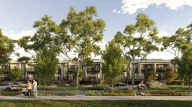The science of shopping
The chemist, the baker, the grocer, the barista. They’re all key to making your local shopping experience the best it can be. But have you ever wondered how they got there? The science of good retail means it’s all by design and never left to chance.
When was the last time you thought about the little community of retailers that co-exist down at your local shopping centre?
If you visit regularly chances are you’ve acknowledged, even subconsciously, that it provides what you need in terms of conveniences and services, as well as comforts like cafes, entertainment, and places to take the kids or meet with friends. None of that is by accident or guesswork. In fact, getting the right mix of experiences and retailers in a shopping centre requires a good deal of science, as the team from Frasers Property Australia will tell you.
“What's interesting about retail is because everyone goes to a shop, everyone thinks that they understand what works and what doesn’t,” says Felicity Armstrong, Frasers Property’s General Manager Retail Investments. “Personal experience is an important factor but isn’t always universal. What we do at Frasers Property is look at the specific communities we're trying to serve, gather as much information about those communities as we can, and tailor a response that fits.
“Those responses can be quite unique. People might think every neighbourhood shopping centre is the same, but they're actually not. There's nuance in every single market.”
Over the years, the Frasers Property retail team have developed a sophisticated data-driven approach to determining the right tenancy mix and customer experience in their centres. That approach includes the layering of multiple data sources, such as demographic analysis, purchaser behaviour, projected population growth, and good old fashioned first-person observation.
“The approach we take is to build the most comprehensive picture we can,” explains Felicity. “I'm sure there are others that rely on one set of data to develop their retail mix, and that's fine. But for us, that's just not enough. We want to be more informed than that. So, we get out there in the area to understand what it’s like to be a local.
“You have to get intimately involved. We drive the streets and observe things like how many cars are in the driveway and whether there are kids' bikes on the lawn. That tells you a lot about household composition. We also check out where locals are currently doing their grocery shopping. Are people doing basket shops or trolley shops? What's on the shelves? What type of product range is the supermarket stocking?”
That kind of keen anthropological observation is key to getting a complete picture of the opportunities says Megan Wong, National Marketing Manager with Frasers Property’s retail team.
“The real work for us begins once we're open and trading, and we can see how people are experiencing the centre,” says Megan. “That's when we start to fine tune how we're managing the asset and how we're leasing and mixing. We're observing all the time what people are doing, how they're interacting with the space, and when they're coming and going.”
The wisdom of experience
At the company’s Ed.Square community in Sydney’s southwest, observations from Ed.Square Town Centre’s first year of trading revealed that it was already becoming more than a local destination.
“The Ed.Square Town Centre is very much the heart of that community and we were always confident that it would be a much-loved neighbourhood asset, especially with the mix of restaurants, shopping, and entertainment we put in there,” says Megan. “But what we’ve seen is that there is a whole other cohort of people who are travelling from further away than we had anticipated to come to our food and beverage and entertainment offer. So that gives us confidence as we plan stage two of the Town Centre, to introduce even more of that experience.”
It’s a similar picture at the award-winning Burwood Brickworks Shopping Centre in Melbourne’s eastern suburbs, where time spent speaking with customers has revealed some surprising drawcards. p>Recognised as the world’s most sustainable retail centre, Burwood Brickworks Shopping Centre required the Woolworths supermarket to save energy by putting doors on its chilled section fridges. This seemingly innocuous action has resulted in customers travelling from several suburbs away because the ambient temperature inside the store is simply more comfortable to shop in. It’s a datapoint that the Frasers Property team learned from hanging out at Burwood Brickworks and asking customers their thoughts on the new shopping centre.
“It’s an incredibly important thing to do,” says Megan. “You can’t just build a multi-million-dollar asset like this and then walk away. You have to stay close to what’s happening on the ground. There are always new things to learn that you can use to improve the shopper experience.”
It would be easy to think that the countless hours that the Frasers Property retail team spend on data capture, observation, and analysis means their jobs are dry and boring. Nothing could be further from the truth, says Felicity.
“I can see how people would think that. But the science of retail exists because of the emotional connection we hope people will make. Their neighbourhood shops should feel like a place they own – —it’s their local, their place to take the kids for ice-cream, or meet up with friends for lunch or dinner. And I think that’s something we do exceptionally well at Frasers Property: integrating retail so it becomes an extension of their residential community.”










